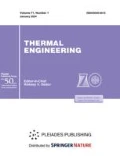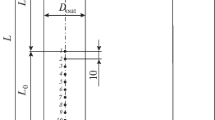Abstract
The main direction of improvement of gas-turbine plants (GTP) and gas-turbine engines (GTE) is increasing the gas temperature at the turbine inlet. For the solution of this problem, promising systems of intensification of heat exchange in cooled turbine blades are developed. With this purpose, studies of the efficiency of the cooling channel of the nozzle blade in the basic modification and of the channel after constructive measures for improvement of the cooling system by the method of calorimetry in a liquid-metal thermostat were conducted. The combined system of heat-exchange intensification with the complicated scheme of branched channels is developed; it consists of a vortex matrix and three rows of inclined intermittent trip strips. The maximum value of hydraulic resistance ξ is observed at the first row of the trip strips, which is connected with the effect of dynamic impact of airflow on the channel walls, its turbulence, and rotation by 117° at the inlet to the channels formed by the trip strips. These factors explain the high value of hydraulic resistance equal to 3.7–3.4 for the first row of the trip strips. The obtained effect was also confirmed by the results of thermal tests, i.e., the unevenness of heat transfer on the back and on the trough of the blade is observed at the first row of the trip strips, which amounts 8–12%. This unevenness has a fading character; at the second row of the trip strips, it amounts to 3–7%, and it is almost absent at the third row. At the area of vortex matrix, the intensity of heat exchange on the blade back is higher as compared to the trough, which is explained by the different height of the matrix ribs on its opposite sides. The design changes in the nozzle blade of basic modification made it possible to increase the intensity of heat exchange by 20–50% in the area of the vortex matrix and by 15–30% on the section of inclined intermittent trip strips. As a result of research, new criteria dependences for the complicated systems of heat exchange intensification were obtained. The design of nozzle blades can be used when developing the promising high-temperature gas turbines.
Similar content being viewed by others
References
V. L. Ivanov, Air Cooling of Gas Turbine Blades (MGTU im. N.E. Baumana, Moscow, 2013) [in Russian].
A. V. Vikulin, N. L. Yaroslavtsev, and V. A. Zemlyanaya, “Study of heat exchange in cooling systems of heatstressed structures,” Therm. Eng. 64, 32–36 (2017). doi 10.1134/S0040601517010104
A. A. Inozemtsev and V. L. Sandratskii, Gas Turbine Engines (Aviadvigatel’, Perm, 2008) [in Russian].
A. V. Vikulin, N. L. Yaroslavtsev, and V. A. Chesnova, “Development of the design scheme of cooling for a nozzle vane of high pressure turbine of gas turbine engine,” Russ. Aeronaut. 59, 58–63 (2016). doi 10.3103/S1068799816010098
V. G. Popov, A. V. Vikulin, and V. A. Chesnova, “Investigation of hydraulic resistance of the slotted channel with separate crosspieces in the cooling systems of blades in high-temperature gas turbines,” Izv. Samar. Nauchn. Ts. Ross. Akad. Nauk 15, 819–824 (2013).
V. G. Popov, A. V. Vikulin, and N. L. Yaroslavtsev, “Calorimetric method of the thermal control of heatstressed parts of gas-turbine engines and gas-turbine installations,” Vestn. MATI, No. 18, 50–58 (2011).
A. V. Vikulin, N. L. Yaroslavtsev, and V. A. Chesnova, “Diagnostics of efficiency for a cooling system of compact heat exchangers with coplanar channels,” Russ. Aeronaut. 59, 395–401 (2016). doi 10.3103/S1068799816030168
V. G. Popov, A. V. Vikulin, N. L. Yaroslavtsev, and V. A. Chesnova, “Analysis of the possibility to expand the control range of complex-shaped channel capacity of heat-stressed structures,” Aviats. Prom-st., No. 2, 20–28 (2013).
V. A. Chesnova, V. G. Popov, and A. V. Vikulin, “Improving the construction of cooled blades of hightemperature gas turbines with the goal to increase reliability and service life of modern aviation gas turbine engines and power gas turbine units,” Vestn. Rybinsk. Gos. Aviats. Tekhnol. Akad. im. P.A. Solov’eva, No. 2, 7–11 (2012).
Author information
Authors and Affiliations
Corresponding author
Additional information
Original Russian Text © A.V. Vikulin, N.L. Yaroslavtsev, V.A. Zemlyanaya, 2018, published in Teploenergetika.
Rights and permissions
About this article
Cite this article
Vikulin, A.V., Yaroslavtsev, N.L. & Zemlyanaya, V.A. Estimation of Efficiency of the Cooling Channel of the Nozzle Blade of Gas-Turbine Engines. Therm. Eng. 65, 88–92 (2018). https://doi.org/10.1134/S0040601517120102
Received:
Accepted:
Published:
Issue Date:
DOI: https://doi.org/10.1134/S0040601517120102




